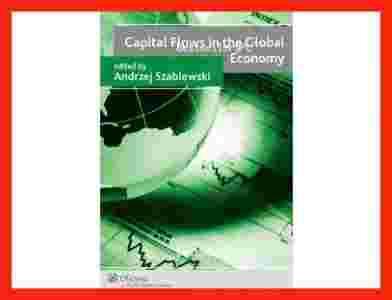Opis książki:
This book is a result of research on both theory and practice of capital flows in the global economy. The research has been performed by a team of economics from the Collegium of Business Administration, at Warsaw School of Economics. The authors focus primarily on the origins of world financial crisis and on the new directions of capital flows. Additionally, the authors discuss the impact of the process of capital accumulation by China and India on the world economy, mechanisms of shaping crude oil prices as well as growing importance of remittances.
Introduction
pp.
Andrzej Szablewski
Chapter 1. Capital flows and multi-currency global monetary system
pp.
1.1. Overcoming Moral Crisis and Value Crisis
pp.
1.2. In Search for New Scientific Paradigms
pp.
1.3. Renaissance of State in Economy as Durable Recipe for Success?
pp.
1.4. Forecasts of GDP Decrease and Increase
pp.
1.5. Capital Surpluses and Deficiencies
pp.
1.6. New Capital Provider: Sovereign Wealth Funds (SWFs)
pp.
1.7. Conclusions from the Long-Term Technical Analysis for the American Market
pp.
1.8. Multi-Currency Global Monetary System in the Next Decade!
pp.
1.8.1. New Super Bubble on the Horizon: US Bonds and Dollar Weakening
pp.
1.8.2. Strengthening of the Euro
pp.
1.8.3. Growing Aspirations of Renminbi: New Active Policy of China
pp.
1.9. Conclusions
pp.
Alfred Bieć
Chapter 2. The Second Economic Crisis of the 21st Century: Causes and Forecasts
2.1. Introduction
pp.
2.2. Crude Oil Prices
pp.
2.3. Food and Metal Prices
pp.
2.4. The Financial Market Crisis
pp.
2.5. GDP and Export Growth in the World and Selected Regions - Forecast to 2015
pp.
2.6. Conclusions
pp.
Krzysztof Rybiński
Chapter 3. The Financial Crisis: Its Origins and Consequences
pp.
3.1. The Mechanism of Speculative Bubble and Crisis Escalation
pp.
3.2. How Should We Respond to the High Risk of An Asset-Price Bubble?
pp.
3.3. The Strategy of the Polish Government: The Free Rider Strategy and the Golden Polish Decade
pp.
3.4. Questions for the Future
pp.
Katarzyna Żądło
Chapter 4. Crisis versus Trust - Conclusions from the Global Economy Problems of Today
pp.
4.1. Trust as a Function of Risk Perception
pp.
4.2. Liquidity or Trust Crisis?
pp.
4.2.1. Trust Deficit as a Derivative of Bad Communication. Situation of the Fortis Group
pp.
4.2.2. Communication as a Factor Constituting the Culture of Trust. Importance of Communication on the Capital Market
pp.
4.3. Pessimistic Perspectives
pp.
4.4. Polish experience with Crisis' Effects
pp.
4.5. Conclusions
pp.
Magdalena Mikołajek-Gocejna
Chapter 5. Investor Relations and Possibilities of Competition for Capital
pp.
5.1. Overperformance as the Key Determinant of Competitiveness of Contemporary Economies, Sectors and Enterprises
pp.
5.2. Use of Investor Relations in Competition for Capital
pp.
5.2.1. Changes in Company Operation and Growing Information Needs of Society
pp.
5.2.2. Gaps in the System of Communication between Companies and Their Environment
pp.
5.2.3. New Approach to Investor Relations - Accounting for Investor Expectations in Enterprise Value Management
pp.
5.3. Conclusions
pp.
Mariusz Trzaskowski
Chapter 6. Capital Accumulation by China and India and Its Influence on the Global Economy
pp.
6.1. Transformations of Chinese and Indian Economies in the era of Market Reforms
pp.
6.1.1. Chinese Explosion
pp.
6.1.2. Changes in India
pp.
6.2. Capital Mobilisation and Valuation
pp.
6.2.1. Capital Market in China
pp.
6.2.2. Capital Market in India
pp.
6.2.3. Mobilisation through IPOs
pp.
6.2.4. Financial Systems
pp.
6.3. Capital Flows in China and India
pp.
6.3.1. New Silk Road
pp.
6.3.2. Financial Assets
pp.
6.3.3. Changes in Foreign Currency Reserves
pp.
6.3.4. Global Economic Consequences
pp.
6.3.5. Global Capital Flows
pp.
6.3.6. Foreign Direct Investments
pp.
6.3.7. India, China and the Global Financial System
pp.
6.4. Crisis in India and China
pp.
6.5. Conclusions
pp.
Marek Panfil
Chapter 7. Globalisation of Venture Capital Investments
pp.
7.1. History of Venture Capital Development
pp.
7.2. History of Venture Capital Globalisation
pp.
7.3. Venture Capital Globalisation - Quantitative Approach
pp.
7.3.1 USA
pp.
7.3.2. Europe
pp.
7.3.3. China
pp.
7.4. Global Trends in Venture Capital Investments
pp.
7.5. Conclusions
pp.
Dorota Ciesielska
Chapter 8. Services Offshoring and Foreign Direct Investment
pp.
8.1. Characteristics of Services Offshoring
pp.
8.2. Reasons for the Development and the Scope of Offshoring
pp.
8.3. Offshoring - the Extent of the Phenomenon
pp.
8.4. Foreign Direct Investment
pp.
8.5. General Electric as an Offshoring Pioneer
pp.
8.6. Sources of Success of Indian Global Corporations
pp.
8.7. Conclusions
pp.
Małgorzata Grotte
Chapter 9. Migrant Remittances in Times of Financial Crisis
pp.
9.1. Introduction
pp.
9.2. Migrant Remittances and other Financial Flows, Scale and Significance
pp.
9.2.1. The Scale of Remittance Inflows
pp.
9.2.2. Remittances versus Other International Financial Flows
pp.
9.3. Impact of Remittances on Recipient Economies
pp.
9.3.1. Macro-Level Impact
pp.
9.3.2. Household-Level Perspective
pp.
9.4. Perspectives
pp.
9.4.1. Impact of International Financial Crisis
pp.
9.4.2. Changing Patterns of Migration
pp.
9.4.3. Remittances' Transfer Costs and Technologies
pp.
9.5. Conclusions
pp.
Wojciech Potocki
Chapter 10. Mechanisms Shaping Crude Oil Prices
pp.
10.1. Crude Oil Prices in Retrospect
pp.
10.2. Theory of Exhaustible Resources vs. Reality and Non-Structural Models
pp.
10.2.1. Crude Oil Price and Consumption: Hotelling Rule
pp.
10.2.2. Price and Consumption in Reality
pp.
10.2.3. Explanation of Discrepancies
pp.
10.2.4. Possibilities of Forecasting Crude Oil Prices
pp.
10.2.5. Non-Structural Models
pp.
10.3. Model of Short-Term Market Equilibrium
pp.
10.4. Crude Oil on the Future Markets
pp.
10.4.1. Crude Oil Prices Equilibrium Model on the Futures Market
pp.
10.4.2. Equilibrium Model with the Use of Option Valuation
pp.
10.4.3. Possibilities of Forecasting Crude Oil Price Trend Reversals on the Future Markets
pp.
10.5. Conclusions
pp.
References
pp.
Contributors
pp. 209
|

